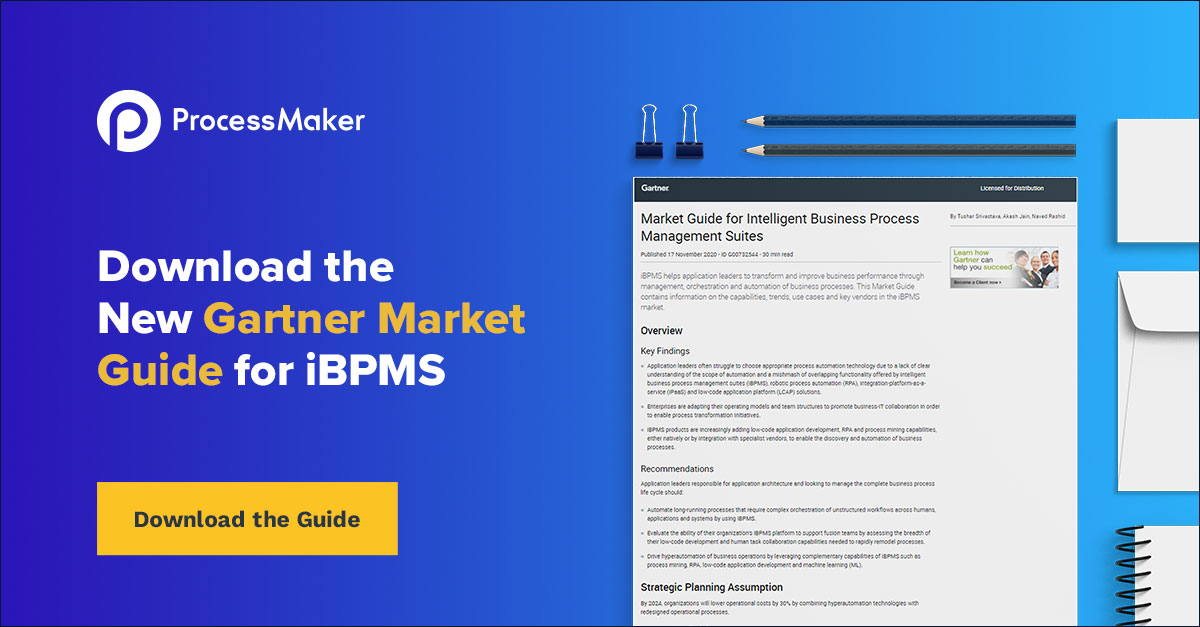In October of 2019, Gartner listed hyper-automation at the top of its Top 10 Strategic Technology Trends for 2020 list. According to Gartner, hyper-automation “involves a combination of tools, including robotic process automation (RPA), intelligent business [process] management software (iBPMS) and AI, with a goal of increasing AI-driven decision making.”
Several months later in December of 2019, Gartner released a report that highlighted organizations’ failures to achieve scale in their automation efforts. These shortcomings are primarily attributable to reliance on too few automation technologies and/or failure to integrate them.
“Enterprise architecture and technology innovation leaders lack a defined strategy to scale automation with tactical and strategic goals. They must deliver end-to-end automation beyond RPA by combining complementary technologies to augment business processes.”
Many organizations have been successful at automating business processes through a single digital technology like robotic process automation (RPA). RPA provides organizations with a quick and cost-effective way to automate routine business processes.
But as Gartner points out, “processes are not always simple, routine, repetitive and stable. They may be long running, and they often involve intelligent automated decision making and optimization. The real challenge – to scale beyond the initial few low-hanging fruits of routine processes – cannot be solved by a single tool or with siloed strategies.” For that, organizations must work towards achieving hyper-automation.
Strategies for Enabling Hyper-Automation
In Gartner’s December 2019 report, they provided three recommendations that organizations should focus on to accelerate their digital transformation initiatives:
- Plan a long-term strategic roadmap that aligns business goals, identifies processes to optimize, and select complementary automation technologies.
- Develop an integration strategy that enables end-to-end process automation using tools from Gartner’s DigitalOps toolbox.
- Augment processes progressively by integrating AI to enable automation of complex business processes and unlock long-term business value.
Organizations that adopt these recommendations to move beyond the automation of simple business processes stand to gain a significant competitive edge in the coming years.
Plan your process automation journey
Key stakeholders must collaborate to set a vision for their automation initiatives by identifying organizational objectives. Gartner advises aligning your automation goals with three core objectives:
- Revenue. Identify your key revenue drivers. For example, your goal might be to offer new services by leveraging new automation solutions.
- Costs. Reduce costs by improving process efficiency and eliminating costly errors.
- Risks. Identify compliance risks associated with inefficient processes. Automating and improving processes minimizes the risks of noncompliance.
From there, stakeholders must identify processes that they wish to optimize and create a long-term automation roadmap using tools from Gartner’s DigitalOps toolbox.
Apply DigitalOps Toolbox
 A DigitalOps toolbox is the set of complementary digital technologies that organizations use to address the different stages of process automation and achieve hyper-automation. These tools include:
A DigitalOps toolbox is the set of complementary digital technologies that organizations use to address the different stages of process automation and achieve hyper-automation. These tools include:
- RPA. RPA is used to automate simple and routine tasks typically handled by humans, allowing employees to focus on higher value tasks.
- iBPMS. An intelligent business process management suite provides powerful tools for automating tasks and orchestrating processes.
- Process Mining and Discovery. Process mining makes it easy to identify inefficiencies and monitor performance through advanced analytics features.
- Low-Code. Low-code platforms help both non-developers and developers to quickly build applications without the need for manual coding. A leading iBPMS offers low-code functionality.
- Business Rules Engine. A business rules engine (BRE) is a core component of a business rules management system (BRMS). A BRE helps organizations to execute and manage business rules and logic.
Augment your Business Processes with AI
To achieve hyper-automation at scale, organizations must establish an integrated system of DigitalOps tools and combine those tools with intelligence technologies such as artificial intelligence (AI) and machine learning (AI).
Organizations can only go so far with standard process automation technologies since they are limited by predefined conditions. In other words, if something occurs outside of the norm it can negatively impact the process since the system lacks the ability to adapt. With AI, however, it is not necessary to preprogram everything. The system adapts and improves over time. This allows organizations to automate more complex business process, achieve hyper-automation at scale, and gain a significant competitive advantage.
ProcessMaker offers an industry leading low-code intelligent business process management suite (iBPMS) that has helped organizations located all over the world to achieve digital transformation.






